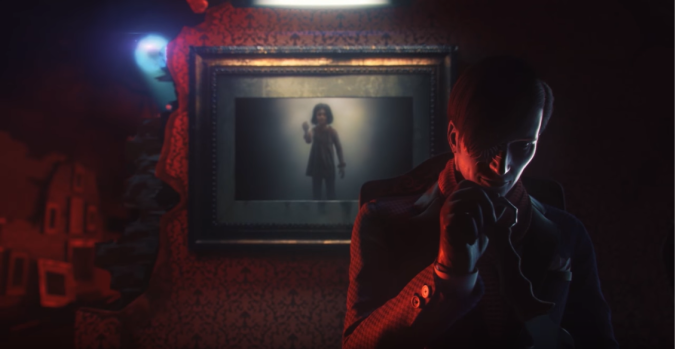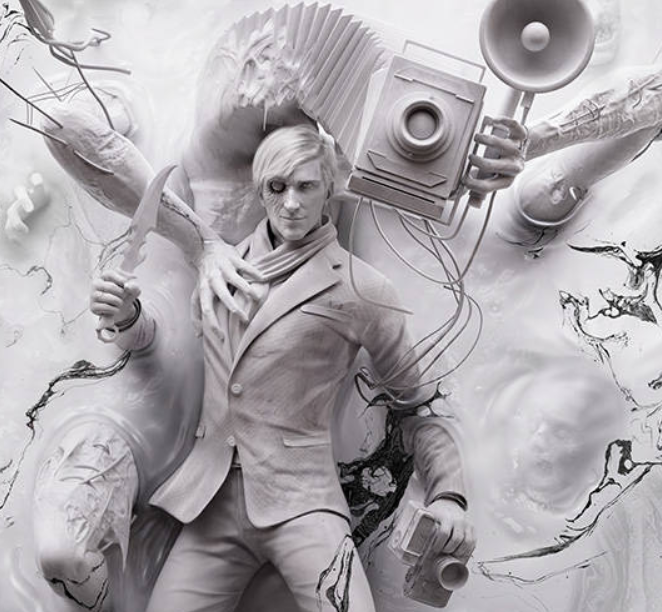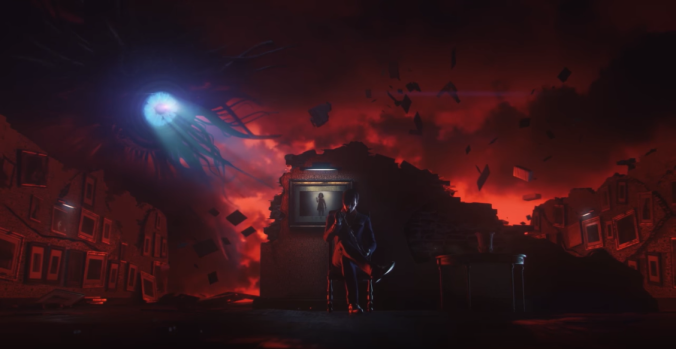WARNING: HUGE SPOILERS FOR THE EVIL WITHIN 2 BELOW. TRUE TERROR.
The first half of The Evil Within 2 is fantastic. That can be credited in large part to its phenomenal villain Stefano, a psychopathic photographer who sews corpses together for art and is accompanied everywhere by a stitched-up pile of limbs and camera parts named Obscura. He’s the solid center that the entire game rotates around: his brutality grabs you the moment you lay eyes on his “work”, and nothing brings him more joy than using his world-manipulating powers to toy with you in unpredictable ways. You spend all your time jumping at shadows because he could show up at any moment and make you the focus of his gleeful sadism. He’s terrifying, and single-handedly makes the game terrifying too.

Aaaaand then you kill him halfway through the story. After an intense final boss fight where you end his macabre gallery show with a well-placed bullet (and an even better-placed one-liner), The Evil Within 2 should come to a close, but stubbornly chooses not to end for ten more hours. The second half of the game spirals into a mess of unnecessary new side characters, edgy religious cliches and such blatant Resident Evil copy-pasting that I’m shocked Nemesis didn’t show up for a cameo. It’s such a sudden and egregious change that I can’t help but think the second half of the story was added later, the result of frantic attempts to build an extra act out of scraps and dartboarded horror tropes.
After everything the first half of The Evil Within 2 accomplished, its sudden quality-plummet is incredibly disappointing – and it didn’t have to happen. The Evil Within 2 has a brilliant story waiting in the wings for Stefano and Obscura that’s never fully explored. Focusing on that for 10 more hours would have made this game into something incredible.

I’m not talking about anything theoretical here – the creators wrote some fascinating stuff about these two that never made it into the game in a meaningful way. This comes from Bethesda’s official description of Stefano:
“After losing his eye in an explosion during his time as a war photographer, Stefano rapidly descended into madness. His newfound ‘vision’ drove him to become fascinated by the precise instant when death takes a person – that split second in time when people are, in his opinion, at their most open and most beautiful. Stefano returned home from the war with a newfound purpose. But he wouldn’t wait for these perfect moments to arise on their own. Why should he, when he could orchestrate those final breaths?”
What the fuck? That’s a fascinating backstory, and we get none of it in the game. As terrifying as Stefano is, much of that comes from the mystery of why he is the way he is, and why he’s trying to turn the shared mind-world of STEM into the inside of a medical waste dumpster. Just when the story catches up to him and starts to make room for character development, the game gets anxious and speeds you along to the part where you murder him.
Taking the time to introduce that backstory would make Stefano into a deeper and even more fascinating character. Plus, his motivation for capturing Lily would be far more interesting in this context, so it would feel like a compelling part of the story rather than a handwaved excuse to tape two plots together. Paying more attention to Stefano as a character could strengthened the entire framework of the game and give even more weight to its stakes.

But where The Evil Within 2 could really strike gold is with Obscura. Again, from Bethesda’s official site:
“‘Stefano’s old spring-wound camera was one of his favorite toys in his collection, and now he’s decorated it with a beautiful tripod,’ explains [Lead Concept Artist Keita] Sakai. ‘The love and affection that Stefano has poured into the camera have become a manifestation of his power, breathing life into Obscura and giving it a will of its own. To Stefano, Obscura is a living work of art, in addition to being his beloved pet. If you see pictures scattered around Union, chances are that some of them were taken by Obscura herself.'”
I am instantly, 100% here for this. This is a Frankenstein story turned on its head. She elevates his motivation and creations into something disturbingly personal and gives him a level of nuance far beyond the “crazy artist” trope he could’ve fallen into. She’s both the only thing he loves outside himself and the core of his identity, his last connection to the outside world swallowed by his narcissism.
And that’s not all Obscura is – there’s a powerful implication that she was once a perfectly normal human who knew and trusted Stefano, and it got her killed. As tension mounts and Sebastian unknowingly draws closer to a confrontation with Obscura, he stumbles on a puzzle revolving around a photo of a model in a blue dress. Once that’s solved, he has to “admire” a photo of presumably the same model, in the same dress, with a bouquet in place of her missing head. Near the photo is an article on the murder of a model named Emily Lewis, whose body was decapitated. The article ends with a comment from one of her loved ones:

“Emily’s longtime friend and photographer Stefano Valentini appeared heartbroken at the news: ‘It’s a terrible thing that happened to my lovely model…at least I was able to capture her essence forever before it was destroyed.'”
The clues paint a horrifying picture: Stefano used his dear friend and trusted artistic confidant to create Obscura. That is far and away one of the most fascinating and complex things in the entirety of The Evil Within 2, and exploring it could easily carry the entire final act. What did these people mean to each other before Stefano descended into madness? How did he get her into STEM? Was Emily crushed under the weight of Stefano’s incredible betrayal, making Obscura the perfect culmination of his savage narcissism, or does some part of her still exist? Two minutes of that story would be more engrossing than the ten hours of gore-covered crosses and weak plot twists we got instead.
To top it all off, that story could be beautifully juxtaposed against the game’s main theme. Sebastian’s abandonment of his wife Myra (when she comes to him with suspicions that their daughter was kidnapped by a nefarious organization and he just about gives her a raspberry) becomes the crux of the game’s story and the basis for its climax. Pairing that with the tale of Stefano and Obscura would create a perfect parallel of trust and betrayal, love and obsession. It establishes a critical link between Sebastian and Stefano and shows how Sebastian must overcome his failures. It would tie the game up wonderfully and give it the great finale it deserves.

At LEAST have them stand next to each other in the actual game.
I want The Evil Within 3. Despite its glaring faults, The Evil Within 2 is such an improvement over the first that I want to see what its creators can do next time. And I hope by then they can hammer out whatever development troubles cut The Evil Within 2 off at the knees and left so much promising material to rot. Until then, I choose to ignore the last half of that bloody story and replace it with my own, imagined ending about two of the most thought-provoking horror game villains in recent memory. Mind over matter.
Advertisements Share this:




